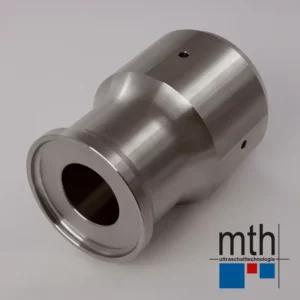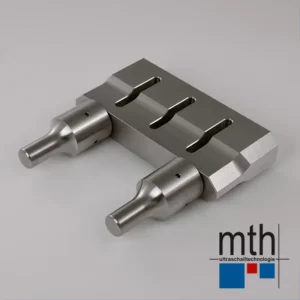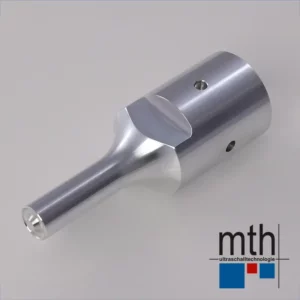Types of sonotrodes








An overview of the different types of sonotrodes
One of the central components: Sonotrodes are one of the central components in ultrasonic technology. They are the ultrasonic components that make direct contact with the workpiece and the ultrasonic energy is directly transmitted.
The variety of types: Each type of horn has its own advantages and limitations and is designed and manufactured according to the requirements of the specific application. There are a large number of different types, which are derived from the shape, function, material, structure or application. Even if these designations are not always standardised and clearly defined, these different sonotrode names provide an overall picture of the different applications, areas of use and customisation options.
Design and requirements: Choosing the right sonotrode design depends on various factors, including the materials, the welding requirements, the geometry of the part and the desired welding quality. We take the requirements of each application into account in order to achieve the best results.
The best-known types of horns include:
Source: https://rittmeyer-beri.de/ultraschall-buch/funktionsprinzip
Sonotrode types according to the shape of the sonotrode or according to the workpiece
Round sonotrodes: These are cylindrical in shape and are often used for welding plastics and thermoplastic materials. They are simple in design, can be constructed with high transmission ratios and are therefore a widely used type of sonotrode.
Web sonotrodes: These sonotrodes are often derived from a cylindrical body and usually have a rectangular cross-section on the welding surface.
Rivet sonotrodes: Both round and web sonotrodes can be provided with rivet contours. For this purpose, the probe has one or more points that penetrate the material and a calotte in which the displaced material is formed into a rivet head. A tip can be dispensed with if the rivet body is already formed as a tube or pin during injection molding.
Contour sonotrodes: These sonotrodes have specially shaped surfaces that are adapted to the contour of the part to be welded. They are ideal for welding complex shapes and irregular surfaces.
Foam and fleece sonotrodes: Foam materials or fleece can be fixed to injection molded parts with a special welding contour.
Radial sonotrodes: These sonotrodes generate vibrations in a radial direction and are often used for welding round parts or pipes.
Roll seam sonotrodes: These are used to weld materials in continuous processes, for example plastic films, textiles or Matell films.
Cutting sonotrodes: This type of sonotrode enables materials to be cut. The cutting geometry is based on the material and the cutting contour.
Depending on requirements, we also produce mixed forms of the different types of sonotrodes.
Further information on our customized versions »
Source: https://rittmeyer-beri.de/ultraschall-buch/funktionsprinzip








Sonotrode types according to the design structure
Monolithic sonotrodes: These are sonotrodes that are made from a single piece of material. They can be made of materials such as aluminum, titanium, steel or other materials. Monolithic sonotrodes are often used in low wear applications as they are robust and easy to manufacture.
Modular sonotrodes: Modular sonotrodes consist of different parts that are connected to each other. These parts can be made of different materials. This enables better adaptation to the specific requirements of the application. For example, the sonotrodes body can be made of a material that enables efficient vibration transmission, while the contacting surface that touches the material is made of a wear-resistant material.
Coated sonotrodes: In some cases, sonotrodes are provided with a coating to improve their wear resistance or special properties. This can be a hard metal coating, for example, which extends the service life of the sonotrodes.
Composite sonotrodes: Sonotrodes can be made up of several components. This is particularly useful if two welding points are to be supplied with a central converter. In this case, two screw-in probes (also called daughter sonotrodes) are attached to the base sonotrode (also called mother sonotrode).
Collet sonotrodes: In some applications, sonotrode heads are designed to be interchangeable. This facilitates replacement when wear or adjustments are required without having to replace the entire sonotrode.
Continue to the sonotrodes product page »
Source: https://rittmeyer-beri.de/ultraschall-buch/funktionsprinzip
Continue to our ultrasonic components
* * * * *Overview page of all ultrasonic products
On the following page you will find an overview of all our product groups – from accessories to the manual welding machine to the custom-made ultrasonic welding machine. To the product overview » * * * * *Ultrasonic converter product group
We supply ultrasonic converters for the common frequencies 20 kHz, 30 kHz, 35 kHz and 40 kHz. We are happy to manufacture special versions with individual performance data for you on request.
To the ultrasonic converters »
* * * * *
Ultrasonic booster product group
As a manufacturer, we are able to produce customized components for our customers. With our ultrasonic boosters, we supply the component with which the amplitude of the sonotrodes is additionally amplified if the transmission ratio within the sonotrode cannot be made sufficiently large.
To the ultrasonic boosters »
* * * * *
Ultrasonic generators product group
We produce ultrasonic generators with frequencies from 20 kHz to 40 kHz – suitable for different applications, devices and machines. We produce our generators in three model ranges, from the lightweight version for manual welding guns to generators with an output of up to 2,000 watts with a Profinet interface for installation in control cabinets.
To the ultrasonic generators »

Do you have any questions?
We are happy to help you personally:


